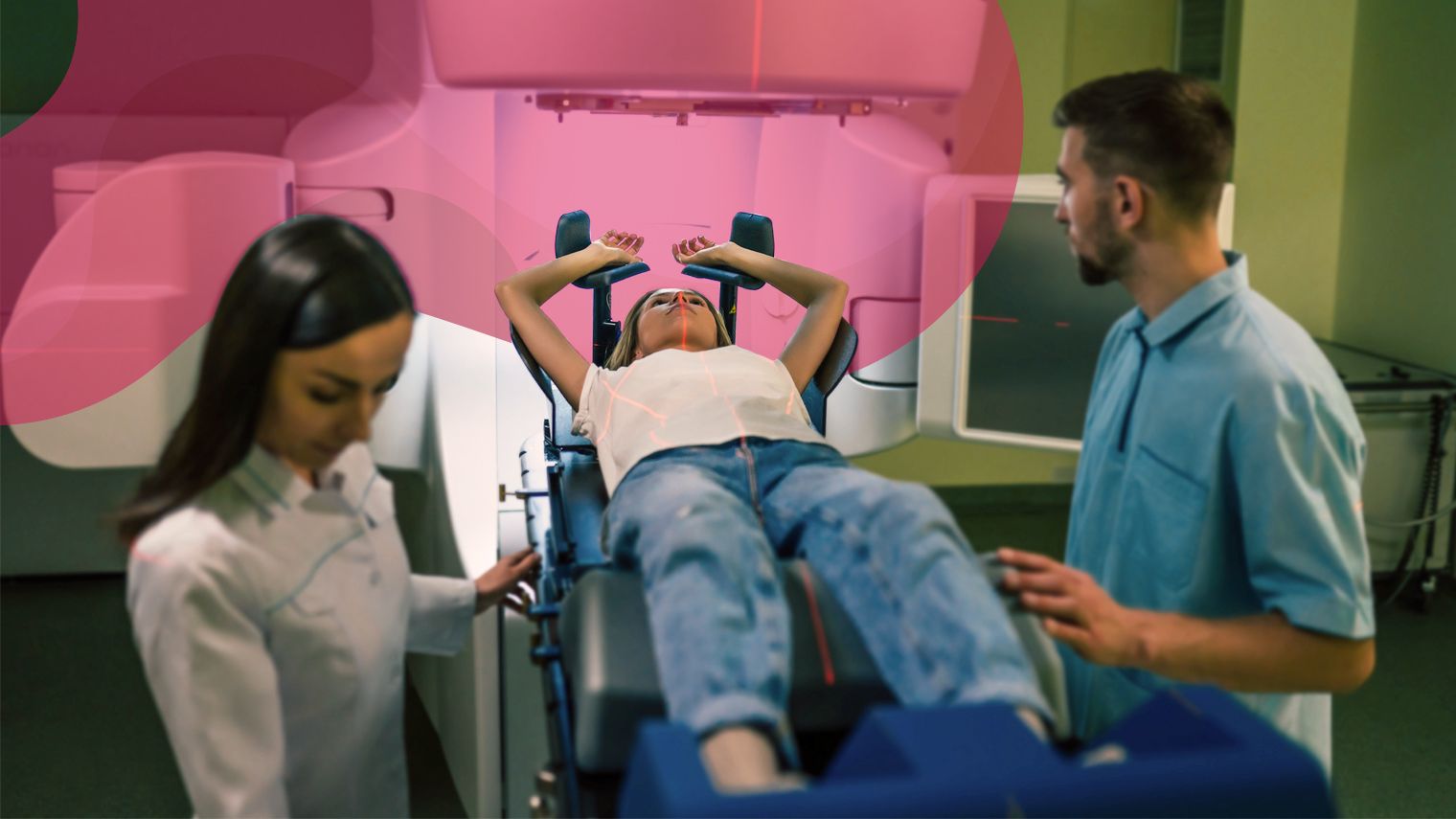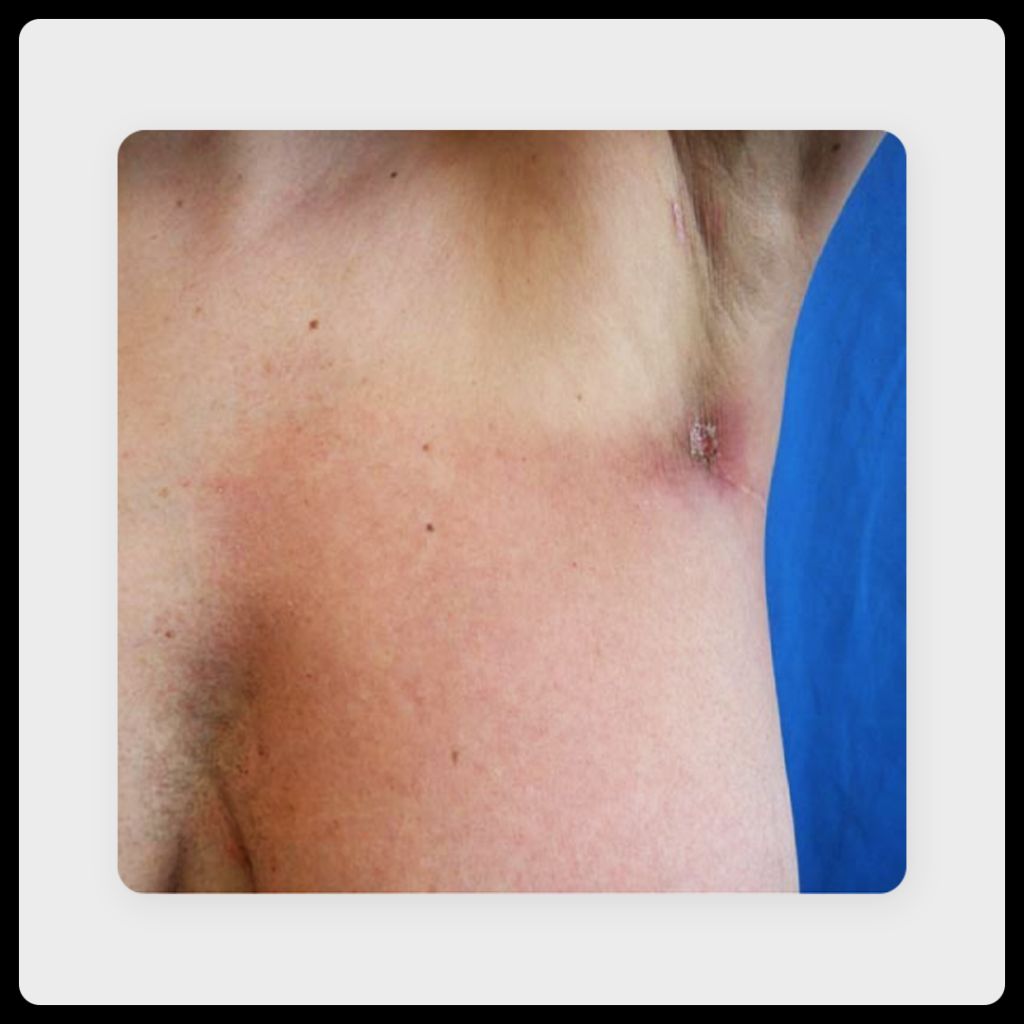What You Need to Know About Breast Radiation Burns
August 30, 2024
Content created for the Bezzy community and sponsored by our partners. Learn More

Photography by Povozniuk/Getty Images
Most people undergoing radiation therapy experience radiation burns, or sunburn-like burning and peeling. There are steps you can take to care for them, like wearing loose clothes and applying barrier creams.
Radiation therapy is a powerful treatment for breast cancer, but it can come with an uncomfortable side effect: radiation burns, also known as radiation dermatitis.
Here’s what you need to know about breast cancer radiation burns that can happen during radiation therapy for breast cancer, including what causes them, how to treat them, and what you and your healthcare team can do to reduce their severity.


What are radiation burns?
Radiation burns happen as a direct result of radiation therapy during breast cancer treatment. They typically build gradually in severity over the course of repeated radiation treatments.
Nearly everyone who gets radiation therapy for breast cancer experiences radiation burns. They can look and feel like a sunburn.
Symptoms include:
- redness
- soreness
- itching
- a burning sensation
- peeling skin
- blisters
- darkening of the skin
What causes radiation burns?
Radiation therapy for breast cancer sends doses of ionizing radiation through the skin into the affected area and out the other side of your body.
It’s effective at damaging the DNA in cancer cells to cause cell death, but it can also damage the healthy tissue it passes through.
Skin cells are especially prone to damage from this ionizing radiation because they have quick turnover compared with other types of tissue in the body.
The delivery of your radiation treatment can affect your chances of getting radiation dermatitis and how severely it affects you. On the other hand, some people’s skin is just more prone to radiation compared to others, no matter how the radiation is delivered.
Factors include:
- how much radiation you receive in a single treatment session
- the total radiation dose you receive over the course of your treatment
- how long you’re exposed to radiation
- volume of the treated area
- effects of other therapies you’re receiving, such as chemotherapy
Radiation burns can come on gradually and are cumulative
Radiation burns are different from a one-time sunburn or sudden burn you might get from touching something hot. They happen gradually and increase in severity as damage accumulates in the skin over repeated treatments.
Radiation can also prevent the skin from healing normally by disabling immune and skin cells in the affected area.
How do you treat and manage radiation burns?
If you have radiation burns or other skin issues in the days, months, or years after radiation treatment, speak with your doctor or a board certified dermatologist.
Things you can do at home
Healthcare professionals recommend several steps to care for your skin after radiation.
These include:
- Wear loose clothing.
- Choose a soft, comfortable bra.
- Avoid extreme heat or cold, including hot tubs or cold packs.
- Don’t apply cosmetic products on the burn area.
- Use only mild soaps and moisturizers.
- Use fragrance-free skin products and detergent.
- Use an electric razor rather than a manual razor, if necessary.
- Don’t expose the area to the sun.
- Leave any lines drawn on your skin during treatment rather than trying to scrub or rub them away.
It’s OK to use deodorant or antiperspirant as you normally would. These products aren’t associated with any harmful effects when it comes to radiation burns.
Topical treatments
Many healthcare professionals recommend that people with radiation dermatitis use a cream and ointment to soothe the area.
Make sure to ask your doctor for a cream or ointment recommendation. This is important because some topical products may have drug interactions or contain ingredients that block the radiotherapy beam.
The product should be formulated to help with localized pain.
How can you prevent radiation burns?
There’s no sure way to completely prevent radiation burns if you’re getting radiation treatment for breast cancer, but a few actions may help reduce the severity.
Topical corticosteroids
High quality studies have shown that applying the topical corticosteroid mometasone furoate, a common treatment for psoriasis and eczema, can help slow the progression of radiation dermatitis during radiation treatment.
Barrier creams
Applying a barrier cream to the area has also been shown to help reduce the severity of radiation burns in breast cancer patients. Speak with your doctor or pharmacist for a recommendation.
You can also use a moisturizing cream to rehydrate if the area is dry, but research shows it doesn’t work as well as a barrier cream to help prevent radiation burns.
Complementary and alternative medicine options
Smaller studies have shown some complementary and alternative treatments may help prevent radiation burns, including taking oral glutamine supplements and applying emulsions of olive oil and calcium hydroxide to the treatment area of your skin.
Melatonin creams have also been shown to help prevent radiation burns and reduce their progression over the course of radiation treatment.
Lifestyle factors
Managing some lifestyle factors, such as quitting or reducing smoking and eating a well-balanced diet based on whole foods, may help reduce the chance or severity of radiation dermatitis.
What do radiation burns look like?
Radiation burns, or radiation dermatitis, can look a lot like a sunburn. They occur on areas where radiation entered and exited your skin during radiation therapy.
Severity can range from slight to severe redness with dry, peeling, itchy skin. More severe radiation burns are wet and deep red in color.
Some people who have undergone radiation therapy for breast cancer may also develop spider veins in the area within months and even years after radiation therapy. These are harmless but may come with some pain and itching.

When to talk with a medical professional
Let your healthcare team know right away if you start experiencing any of the symptoms of radiation burn — even if it’s just mild skin redness or discoloration.
This will help guide their decision making about your treatment dose.
Radiation burns that happen after treatment
Radiation burns can also happen after radiation treatment is complete — even months or years later.
Make sure to speak with your doctor if you experience any signs of radiation burns any time in the weeks, months, or years after your treatment.
Other skin issues
Radiation treatment for breast cancer can also result in other skin issues. See a doctor right away if you think you may be experiencing any of the following:
- Radiation recall: A rare condition in which a drug triggers red, inflamed skin on an area that has previously been exposed to radiation therapy.
- Radiation-induced morphea: A red, round plaque can appear at the site of radiation treatment, later turning into a hardened, discolored area of skin.
- Radiation-induced fibrosis: Skin or other tissues in the radiation field appear scarred or thickened and may contract.
- Skin cancer: In rare cases, radiation damage can cause mutations in the skin that lead to skin cancer. In the months and years after radiation treatment, keep your eyes open for any skin changes on the irradiated area and report them to your doctor.
- Radiation-induced angiosarcomas: These rare but aggressive cancers usually occur 7 to 8 years after radiation therapy. They present like a bruise in the area of radiation.
Frequently asked questions
Here are some quick answers to common questions about radiation burns, or radiation dermatitis.
Who is affected by radiation burn?
Anyone who undergoes radiation therapy for cancer may get a radiation burn or radiation-induced dermatitis. Research shows it’s incredibly common, happening in nearly 100% of people who go through radiation therapy for breast cancer.
It builds up over time, so people who have been receiving treatment for longer are more likely to have it than those who are just beginning radiation.
How long do breast radiation burns last?
If you’re getting radiation treatment for breast cancer, you might start experiencing radiation burns 1 to 4 weeks after beginning treatment. They typically go away a few weeks after treatment.
However, some skin effects happen months or years after stopping radiation treatments.
For example, skin darkening can last years after radiation therapy. If you experience skin changes long after radiation treatment, speak with your doctor.
What is the best cream to use for radiation burns?
There’s no consensus on one single best cream or ointment for radiation burns, but researchers recommend choosing one that focuses on reducing localized pain.
One analysis of studies found that topical corticosteroids helped reduce the severity of radiation dermatitis.
It’s important to ask your doctor to recommend a specific product because some soothing topical creams may interact with another medication you’re taking. Others can block the radiation beam and interfere with your treatment.
What are natural remedies for radiation burns?
Regularly applying a barrier cream may help reduce the severity of radiation burns, according to some research. A moisturizing cream is OK to use, but may not have the same effect.
One small study showed breast cancer radiation patients had significantly lower severity of radiation dermatitis when they regularly applied an emulsion of olive oil and calcium hydroxide to the area.
Creams containing melatonin may also help reduce the incidence and severity of radiation burns.
Taking supplements of the amino acid glutamine may also help, according to early research. Glutamine is known to help with wound healing.
Takeaway
If you’re receiving radiation therapy for breast cancer, you know it can be a challenging journey. On one hand, getting timely, effective treatment is important, and radiation therapy is a gold standard for breast cancer treatment for those undergoing conservation therapy.
At the same time, radiation therapy can be tough because it often comes with side effects — including radiation burns.
But keep going! With the right treatments and prevention techniques, you can help ease radiation burn symptoms and improve your quality of life. And your treatment will be over before you know it.
Medically reviewed on August 30, 2024
13 Sources


Like the story? React, bookmark, or share below:
Have thoughts or suggestions about this article? Email us at article-feedback@bezzy.com.